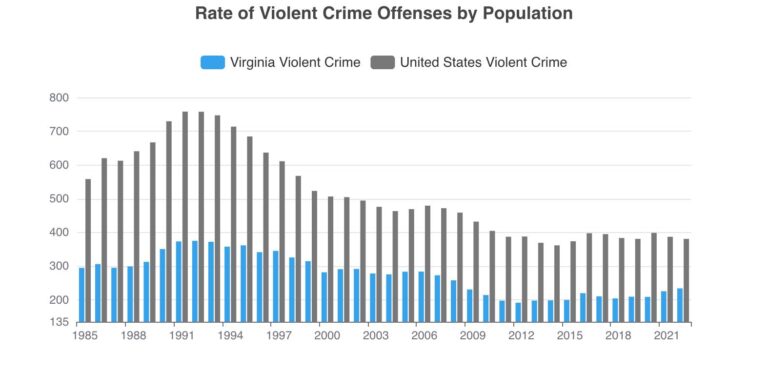The latest FBI data reveals a continued decline in violent crime across the United States, marking the second consecutive year of decreases. According to the report, key indicators such as homicides, aggravated assaults, and robberies have all trended downward, signaling potential progress in national public safety efforts. This development comes amid ongoing debates about crime rates and law enforcement strategies, offering a critical perspective on the state of violent crime in the country.
FBI Reports Continued Decline in Violent Crime Across the Nation
Recent statistics released by the Federal Bureau of Investigation reveal a sustained reduction in violent crime, marking a hopeful trend for communities nationwide. This decline reflects effective law enforcement strategies and increased community engagement, contributing to safer neighborhoods. Key areas showing improvement include:
- Homicides: A notable decrease in overall incidents compared to previous years.
- Aggravated assaults: Declining numbers indicating enhanced preventative measures.
- Robberies: Fewer reported cases, correlating with targeted police initiatives.
Analyzing the data across major urban centers demonstrates varied but overall positive outcomes. The table below summarizes the percentage change in violent crime rates in selected U.S. cities over the past two years:
| City | 2022 Change (%) | 2023 Change (%) |
|---|---|---|
| New York | -5.4 | -3.2 |
| Chicago | -2.1 | -4.8 |
| Los Angeles | -3.7 | -2.9 |
| Houston | -1.5 | -3.5 |
Regional Variations Shed Light on Localized Crime Trends and Challenges
While nationwide figures reflect a promising decline in violent crime, local data reveals a more nuanced picture across different regions. Certain urban areas continue to grapple with elevated rates of specific offenses such as aggravated assault and robbery, largely driven by socioeconomic factors and community-specific challenges. Conversely, some rural counties report stable or even increased instances of property crimes, underscoring the importance of tailored law enforcement strategies that address unique local conditions rather than broad national approaches.
Key factors contributing to regional disparities include:
- Economic stability and unemployment rates
- Community policing initiatives and resources
- Demographic shifts and population density
- Access to social services and youth programs
| Region | Violent Crime Rate Change (YoY) | Primary Challenge |
|---|---|---|
| Midwest | -3.2% | Gang-related incidents |
| South | -1.5% | Domestic violence cases |
| West | -2.8% | Property crimes rise |
| Northeast | -4.0% | Drug-related offenses |
Experts Weigh In on Contributing Factors to the Downward Crime Rate
Crime analysts and law enforcement officials attribute the sustained decrease in violent crime to a combination of multifaceted factors. Among the leading contributors are enhanced community policing efforts, increased investments in social services, and the proliferation of surveillance technologies. Experts emphasize that fostering trust between police and residents has played a critical role, allowing for more effective crime reporting and proactive interventions.
Additional elements influencing the decline include:
- Expanded youth engagement programs reducing gang recruitment
- Improved economic conditions in urban areas
- Widespread adoption of data-driven policing strategies
| Factor | Estimated Impact |
|---|---|
| Community Policing | 35% |
| Youth Programs | 20% |
| Economic Improvement | 25% |
| Technology & Data Use | 20% |
Policy Recommendations Focus on Sustaining Momentum and Addressing Remaining Hotspots
To maintain the recent decline in violent crime, experts urge a multi-faceted approach that integrates community engagement with strategic law enforcement. Emphasizing data-driven policing, officials recommend allocating resources to neighborhoods where incidents remain disproportionately high. This includes enhancing surveillance technologies, expanding social services, and fostering stronger partnerships between police and residents to rebuild trust and cooperation.
- Invest in Youth Programs: Youth mentorship and after-school activities can steer at-risk individuals away from violence.
- Expand Mental Health Support: Increased access to counseling helps address underlying factors contributing to crime.
- Target Repeat Offenders: Focused rehabilitation and monitoring reduce recidivism rates.
| Area | Current Crime Rate | Recommended Strategy |
|---|---|---|
| Urban Centers | High | Increased Patrol and Community Policing |
| Suburban Zones | Moderate | Social Services Expansion |
| Rural Areas | Low | Resource Monitoring and Outreach Programs |
Future Outlook
The latest FBI data highlighting a consecutive decline in violent crime offers a cautiously optimistic snapshot of public safety in the United States. While these figures suggest progress in combating violence, experts stress the importance of sustained efforts and community engagement to maintain and build upon this positive trend. As law enforcement agencies and policymakers analyze these developments, vigilance remains key to ensuring that the downward trajectory continues in the years ahead.







